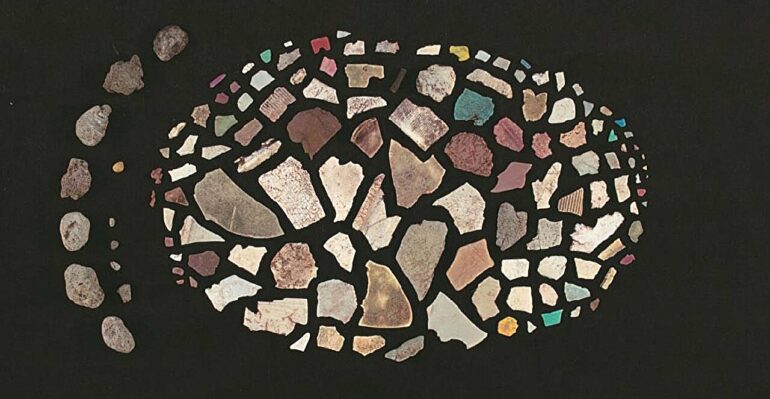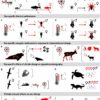Seabirds in the Pacific Ocean are eating plastic and feeding it to their chicks. But we know precious little about why the birds are doing this.
By properly classifying the shards of plastic removed from the stomachs of these birds, researchers are hoping to be able to see any trends that could point to an answer.
On the remote Lord Howe Island, the nesting flesh-footed shearwaters are being fed a toxic diet.
As the adults fly out over the open ocean in search of fish and squid, they have instead been feeding on pieces of the copious plastic that is floating on the surface of the water. The adults then take this plastic back to their nests and feed it to their growing chicks.
This diet of plastic can kill the chicks, as the material leaches chemicals into their bodies, causes internal scarring and simply prevents the birds from eating actual food. But the exact reasons why the adults are eating plastic in the first place are still not really understood.
One difficulty is that analysis of the types, colors, and shapes of plastic being eaten by the birds has historically been very subjective, varying from researcher to researcher and study to study. This has limited the ability to look at any potential trends that could start to answer these questions.
Dr. Joby Razzell Hollis is a researcher at the Natural History Museum who has been developing a way to standardize the assessment of plastic pollution like that recovered from the stomachs of flesh-footed shearwaters. He has a new machine learning tool that will automatically measure not only how many pieces are present, but also their shape, color and size.
“We know that seabirds such as the flesh-footed shearwater, as well as sea turtles, eat plastic because they mistake it for food,” says Joby. “And one of the questions that we have not managed to adequately answer for these species is what about plastic makes it look so appealing.”
“Are they targeting certain colors or is it about just simply how visible it is in the ocean? That would raise questions about foraging style and strategies. But it could also give us a way of understanding if they’re targeting certain kinds of plastic based on appearance, so we’d know that those are the kinds of plastic we should be trying to remove from the ocean as quickly as possible.”
The work will soon be published in the journal Methods in Ecology and Evolution but is already available online.
Why are birds eating plastic?
Despite a growing recognition of the impact of plastic pollution on the natural world, there is little evidence to show that the problem is abating.
The global production of the material is continuing to grow year-on-year, while the amount of plastic finding its way into the oceans is also persisting. Some estimates suggest that up to 20 million new pieces of plastic enter the ocean each day.
This pollution does not go away, but instead fragments and breaks down into ever smaller chunks with various impacts on the marine environment. Microplastics are eaten by plankton and passed up the food chain, while bigger pieces are often consumed by birds, turtles, fish and whales.
While this is not good for the health of these animals, what is less clear is how it is actually affecting these species. For example, it is not as simple to say that the more plastic an animal eats, the lower its survival rate.
“It is unclear that the mass of plastic is causing the most harm,” explains Joby. “Previous studies have not shown a statistically significant relationship between the amount of plastic eaten and the harm it does to birds.”
“It’s more likely that it also depends on chemical composition, or even size and shape.”
The issue comes when people have tried to measure these characteristics. Someone who looks at a piece of off-white plastic might, for example, say it is variously white, gray or beige. It is extremely difficult to know if people are describing colors in the same way, it is simply too subjective.
But even when it comes to basic aspects that we might think of as being objective, like the number of pieces of plastic recovered from a bird, there can be inconsistencies. When counting hundreds of tiny pieces, people invariably make mistakes, and it can take a long time to measure and calculate the size and shape of each piece.
This is what Joby set out to standardize. By laying out pieces of plastic from the stomachs of birds and taking photographs of them with a color correction card, Joby was able to use machine learning and image processing to create an automated system to count and categorize the shards. This allowed him to not only process hundreds of images containing thousands of bits of plastic in under ten minutes, but do so in a way that can be replicated anywhere in the world.
“This process—for which I’ve made the code publicly available as part of publishing the paper—can be applied to any photograph that’s taken under relatively similar conditions,” says Joby. “So it should provide a way for other researchers to acquire the same kinds of data and in a consistent fashion between researchers and groups.”
Already, the results from the pilot study have shown that there are changes in the composition of plastics being eaten by flesh-footed shearwaters from year to year. While there isn’t enough data yet to figure out what might be behind this shift, it is hoped that over the next few years scientists will be in a much better place to spot and analyze these changes.
“We’re hoping this will significantly increase our ability to monitor the properties of these objects in the future,” says Joby, “and also make it faster and more reliable so that we can understand better what’s going on with plastic in the ocean.”
More information:
Joseph Razzell Hollis et al, Quantitative photography for rapid, reliable measurement of marine macro‐plastic pollution, Methods in Ecology and Evolution (2023). DOI: 10.1111/2041-210X.14267
Provided by
Natural History Museum
This story is republished courtesy of Natural History Museum. Read the original story here.
Citation:
Machine learning could help scientists understand why birds are eating plastic (2023, December 18)



